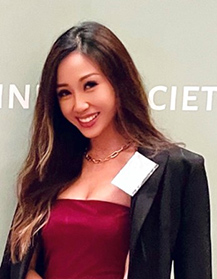
Rina Lai earned her PhD at the University of Cambridge where she designed and developed the Computational Thinking Challenge, a computerised assessment for computational thinking. While researching at the university, she supervised undergraduate and postgraduate students in education, neuroscience, and quantitative research methods, amongst other courses. She also worked with teams at Cambridge Mathematics and Arm to create a computational thinking framework.
1. What’s your earliest memory of doing mathematics?
Boring! When I think of my earliest memory of mathematics I see a quiet classroom, a strict teacher, and hours of after-school tutorials in Hong Kong. The picture is naturally dull, unfortunately. My interest in mathematics was really ignited in high school when I was introduced to applied mathematics, and then later at university when statistics became one of the most fascinating subjects to me. When I first dived into the world of applied mathematics, I discovered its close connection to the real world, which I found relevant and fun. This feeling was even stronger when I took statistics at university: transforming psychological phenomena into quantifiable variables and understanding the world through data has gifted me a new lens to see the world; it has fundamentally changed the way I perceive the world. It is anything but dull!
2. How has mathematics education changed in the time you have been involved in it?
I think mathematics, alongside other areas in education, has changed immensely over time. Learning mathematics is no longer an individual journey; rather, it could be a collaborative process with peers. The content is also much more diverse and dynamic now. For example, young students today can grasp mathematical ideas through robotics, tangible objects, and games. Older students can enhance their understanding by solving complex real-world problems using mathematics. In my consulting work, I have worked with EdTech founders who are leveraging technology to enhance students’ learning experiences not just in mathematics but also in STEM. I believe there will be many more new ways for students to access, learn and apply mathematics in the future. I also think learning and teaching in mathematics education may transcend the disciplinary boundary. For example, students may learn mathematics at the same time as they are learning how to code. I feel excited when I think about the fun students could have in learning mathematics now and in the future!
3. Tell me about a time in your career when something totally flabbergasted you.
Before I was introduced to applied mathematics in grade 12, I thought the world had only pure mathematics and I thought mathematics was my least favourite subject. The moment I attended my very first class in applied mathematics, I immediately connected with the problems and the whole dynamic changed ever since!
4. Do you practise mathematics differently in company?
Yes, and I do enjoy practising mathematics in company. Where is the fun in solving problems and not sharing them with your colleagues, students or friends? There is a sense of fulfilment in practising and solving problems, but this sense of fulfilment is usually stronger when you have people sharing that experience. After analysing data, my favourite moment is to share my interpretations with colleagues from different disciplines and see if they have other ways to interpret it.
5. Do you think a brilliant maths teacher is born or made?
I don’t think it’s exclusive. A brilliant maths teacher can be both born and made but I think the latter is more important when it comes to teaching because it indicates willingness and motivation. These are qualities that would help a brilliant mathematician become a great maths teacher. It is really the desire to be professionally “developed” for the greatness of teaching that distinguishes the amazing teachers, in my opinion.
6. What’s the most fun a mathematician can have?
Great question! I think fun is often underappreciated when it comes to formal learning in mathematics. Fun is when you are applying mathematics in a context that you can relate to, solving problems that are close to your heart and sharing the outcomes with people around you. When I supervise students who have never learned statistics, I like to start with real-world problems that they find interesting. This is because the first time we encounter something unfamiliar, it can feel scary (especially when you are dealing with numbers). So, starting with something familiar and personal can help seed students’ interests and love for statistics, or for mathematics in general. I once had a student who expressed her anxiety about conducting a small research project using quantitative methods. I encouraged her to find a question that she was at least a little enthusiastic about. By the end of the term, she came to me with so much excitement about what she had discovered when the project was completed. So, the fun comes when you discover something in the unknown and something that you can relate to! I think students will experience more fun in mathematics if schools provide more opportunities for students to share their discoveries or strategies with each other.
7. Do you have a favourite maths joke?
Not sure how politically correct this is but a mathematician friend told me this joke:
“How can you tell an extroverted mathematician from an introverted one?”
“When talking to you the introverted mathematician looks at their own shoes, the extroverted one looks at your shoes.”
Well, I laughed.
Join the conversation: You can tweet us @CambridgeMaths or comment below.